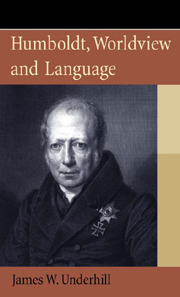Book contents
- Frontmatter
- Contents
- Acknowledgements
- Preface
- Part I Language and World
- Part II Humboldt, Man and Language
- 7 Worldview (Weltanschauung or Weltansicht)
- 8 Sprache
- 9 The Work of the Mind
- 10 Form
- 11 Creativity, Culture and Character
- 12 Catching the Character
- 13 A Seeing and Feeling Worldview
- 14 Four Dangers in the Comparative Approach
- 15 Reformulating the Worldview Hypothesis World
- 16 A Final Word
- Glossary
- Bibliography
- Index
11 - Creativity, Culture and Character
from Part II - Humboldt, Man and Language
Published online by Cambridge University Press: 12 September 2012
- Frontmatter
- Contents
- Acknowledgements
- Preface
- Part I Language and World
- Part II Humboldt, Man and Language
- 7 Worldview (Weltanschauung or Weltansicht)
- 8 Sprache
- 9 The Work of the Mind
- 10 Form
- 11 Creativity, Culture and Character
- 12 Catching the Character
- 13 A Seeing and Feeling Worldview
- 14 Four Dangers in the Comparative Approach
- 15 Reformulating the Worldview Hypothesis World
- 16 A Final Word
- Glossary
- Bibliography
- Index
Summary
As the friend of Schiller, Humboldt was influenced by the Storm and Stress pre-Romantic movement (Sturm und Drang) to which both Schiller and Goethe belonged. During the 1790s, Humboldt was engaged in working on Goethe's epic poem, Hermann and Dorothy. It is not by chance then that the metaphors which structure Humboldt's thought and the vocabulary that colours it are often reshaped from the words, concepts and metaphors common to the discourse of the Zeitgeist that Goethe and Schiller incarnated. Humboldt incessantly returns to formulations of an organic and sexual kind to describe the growth of languages as a process of fertilization and gestation. And, as we have seen above, the speaking subject is characterised as being animated by a vital inner urge to break through to expression in much the same way as the lyrical personae of Goethe's poems strive to express themselves. The expression individueller Drang (individual urge) is not, it would seem, accidental.
Humboldt was no doubt in agreement with Goethe when he argued that the German of the eighteenth century had been going through a period of cultural, intellectual and linguistic gestation. He may well have agreed with Goethe on the poet's estimation of his own contribution to the advancement of German culture. Goethe, for his part, described the German of his youth as ‘a clean tablet, on which one could hope to paint good things with pleasure’ (Goethe, in Eckermann 1998: 295).
- Type
- Chapter
- Information
- Humboldt Worldview and Language , pp. 81 - 96Publisher: Edinburgh University PressPrint publication year: 2009



